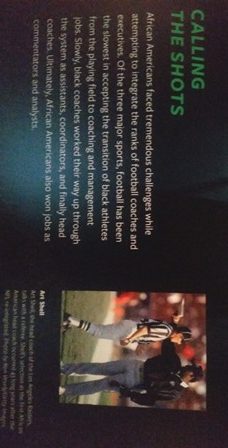
Friday, September 23, 2016
Museum of African American History and Culture offers inspirational message
Every year I get a little closer to understanding why I am passionately in love with African American history and culture. But every year it becomes less necessary to explain my love to anyone else.
I got a sneak-peek at the Smithsonian’s new Museum of African American History and Culture. I am relieved that this place will have thousands of visitors every day for centuries because each day there will be fewer people surprised by my passion for Black history and culture.
Most museums have a Black exhibit somewhere inside. This museum, however, is a feast for the gluttonous, like me. Hall after hall is filled with the beauty and style of sports, art, food, comedy, politics, military, science, innovation, perseverance, building, optimism, struggle, invention, legislation, crafts and organization. The museum is huge and the triumphant stories, like Black people, never stop.
The Eastern Shore pops up in many exhibits: UMES alumnus Art Shell (below), Chesapeake watermen, 1960s Civil Rights’ activist Gloria Richardson of the Cambridge Movement, Harriet Tubman and Frederick Douglass. This is history most of us know. But this much space also allows for delightfully engaging and unexpected topics, such as an explanation of Black gestures: distinct ways to communicate thoughts and feelings without words: “leans and stances, struts, strolls and swaggers, switches and sashays.…”

The magnitude of the building appropriately reflects the magnitude of Black history. There is no one Black history, there is no one Black experience. Alongside the ominous concrete guard tower from the Angola plantation prison stands a sturdy log cabin from a Midwestern town civilized by self-freed Black Americans.
Good-hearted and well-meaning people are reacting to the museum already. One visitor predicted it will help us see that African Americans are American too, and have made tremendous contributions to America. A nice thought, but this notion is so last century.
Also last century is a memorable line from a 1926 Langston Hughes poem shouting from a wall of the new museum: “I, too, am America.” We know better now, Langston. We know more now. We can drop the “too.” Black people are America. This museum will push us past the contribution stage of thinking about Black history.
White people need African American history. It is not a “nice-to-have.” It is not extra. It is not an elective. Knowledge of American history from Black perspectives is required to understand this place where we live, the architecture of our lives, this food that we eat, this music we move to, these ideas in our heads. There is nothing on this land and in our ways that is separate from Black history. There is no Non-African-American history.
Emory University historian Carol Anderson, in her recent best-seller, warns of the dangers of building our laws and policies on myths. Black history is necessary for us to stop fooling ourselves and lying to ourselves. In the cavernous lower level of the museum, Ida B. Wells’ brilliant words tower over a 1940s Jim Crow-era railcar: “The way to right wrongs is to turn the light of truth upon them.” This museum and all that it will inspire are opportunities for white people to be better.
In an arts’ exhibit, actress Ruby Dee’s peace-filled eyes see us above her wise words: “We used the arts as part of our struggle.” We can all do what Ruby Dee did. We can all be warriors in the struggle for full citizenship for all of us.
No matter our job, no matter our income, no matter our address, no matter our ability or disability, we can all join the struggle to extend the dignity of humanity to us all. What else is there to do?
This review was published Sept. 23, 2016 as a guest column in The (Salisbury, Md.) Daily Times newspaper.

